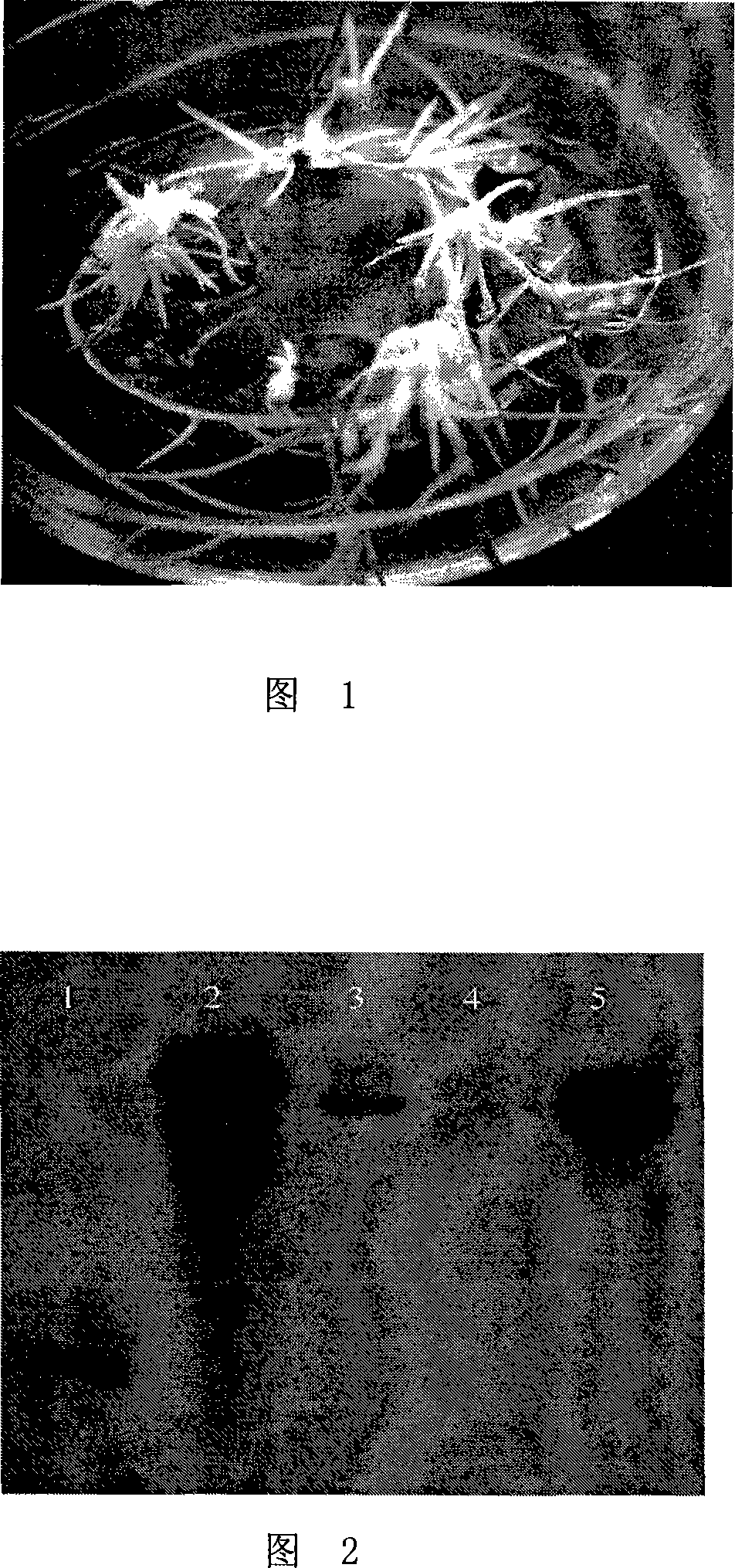Method for evoking liquorice to generate hairy root
A hairy root and licorice technology, applied to cells modified by the introduction of foreign genetic material, introduction of foreign genetic material using a vector, recombinant DNA technology, etc. It is not a very high problem, and it can shorten the time and improve the conversion efficiency.
- Summary
- Abstract
- Description
- Claims
- Application Information
AI Technical Summary
Problems solved by technology
Method used
Image
Examples
Embodiment 1
[0016] Embodiment 1, carry out the induction of Radix Glycyrrhizae hair root with the method of the present invention
[0017] In this example, the cotyledon node of Glycyrrhiza uralensis seeds three days after germination was used as the recipient material; Agrobacterium rhizogenes A4 was used as the mediating strain, which contained Ri plasmid and had no resistance.
[0018] The specific operation steps are as follows:
[0019] 1. Spread the A4 strain of Agrobacterium rhizogenes on the YEB solid culture, and culture it at 28°C for 2 days to grow a single colony;
[0020] 2. Randomly pick Agrobacterium rhizogenes A4 clone colonies in liquid YEB medium, shake culture at 28°C until OD 600 ≈0.6-0.9, then take 1ml of bacterial liquid into 100ml of YEB liquid medium and shake it to OD 600 ≈0.5-0.7, collect the bacterial liquid, centrifuge at 3500rpm for 10 minutes to collect the bacterial cells;
[0021] 3. Mix the collected bacteria with MS liquid medium equal to the volume of...
Embodiment 2
[0026] Embodiment 2, the molecular detection of hair root system
[0027] Three licorice hairy root lines obtained in Example 1 were randomly selected, the total DNA was extracted by the CTAB method, and the rolC gene fragment related to root formation on the digoxin-labeled Ri plasmid was used as a probe for southern hybridization. The results of hybridization showed that all the obtained hairy root lines were positive, which proved that the T-DNA region in Agrobacterium rhizogenes had been successfully integrated into the genomic DNA of licorice root. As shown in Figure 2, 1-3 are different transgenic hairy roots respectively, wherein the probe is a digoxin-labeled rolC gene fragment; 4 is the non-transgenic negative control (common licorice group bacon); 5 is the positive control hairy root Ri plasmid of Agrobacterium A4.
Embodiment 3
[0028] Embodiment 3, the total flavonoid content detection in hair root system
[0029] The content of total flavonoids in licorice root system was detected by ultraviolet spectrophotometer: take licorice root samples subcultured for 20 days, dry at 60°C to constant weight, grind, pass through a 60-mesh sieve, accurately weigh 0.1g powder, and dilute with methanol Ultrasonic extraction of the solvent twice, 30min each time, centrifugation, combined filtrate to 10ml, take 100μl, add 1ml of methanol and 0.5m110% sodium hydroxide, dilute to 2ml, take naringin as the standard, and use ultraviolet spectrometry The photometer detects at a wavelength of 420nm, and calculates the percentage of the total flavonoids in the dry weight of the hair root.
[0030] The results show that the total flavonoids of active ingredients in licorice root are high, and the content can reach 1.6% of the dry weight of hair root, which is more than twice that of wild licorice root (about 0.7% in root).
PUM
 Login to View More
Login to View More Abstract
Description
Claims
Application Information
 Login to View More
Login to View More - R&D
- Intellectual Property
- Life Sciences
- Materials
- Tech Scout
- Unparalleled Data Quality
- Higher Quality Content
- 60% Fewer Hallucinations
Browse by: Latest US Patents, China's latest patents, Technical Efficacy Thesaurus, Application Domain, Technology Topic, Popular Technical Reports.
© 2025 PatSnap. All rights reserved.Legal|Privacy policy|Modern Slavery Act Transparency Statement|Sitemap|About US| Contact US: help@patsnap.com

